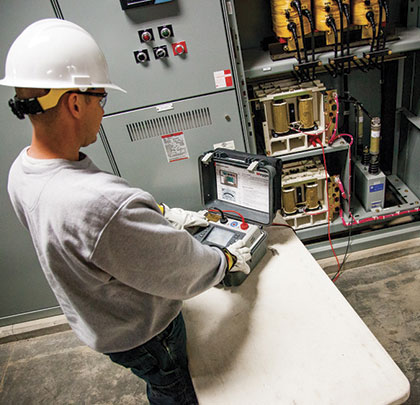In part 1 of this series, we noted how it is critical to know the electrical condition (IR) of the insulation in your equipment at all times—and that personnel safety and operating reliability can both be compromised by the often harsh operating environments where electrical insulation can be exposed to extreme operating temperatures, moisture, and chemical contamination. With that in mind, in this installment we will dive deep into the issues with manual IR testing.
ISSUES WITH MANUAL IR TESTING
Because manual IR testers are normally portable, they are most commonly used in the field for troubleshooting existing problems. They are also used to perform a final “Spot type” check to confirm the reliability of the electrical equipment’s insulation. This is to ensure that there are no leakage currents present from unintended faults in the insulation caused by age, moisture, contamination, or thermal breakdown. For example, a grounded stator winding caused by surface moisture present on the coils would be obvious from the IR testing results. However, there are several downsides to this type of manual IR Testing. They are as follows:
- Manual IR testing allows for human error to become a factor during the testing which will cause the IR test readings to be inaccurate. Improper testing procedures and mistakes made during testing can result in damage to the equipment being tested and injury to personnel performing the testing.
- Manual IR testing exposes personnel to dangerous Arc Flash and Electrical injury type accidents. Personnel accessing electrical control cabinets to perform IR testing is one of the leading causes of electrical Arc Flash injuries and fatalities.
- Manual IR testing allows for the improper type of testing device to be used, such as an AC Hi-Pot tester, which requires a skilled and experienced technician to operate. When Hi-Pot testing is done incorrectly it can cause damage the electrical insulation itself and can harm personnel coming in contact with the equipment being tested.
- Manual IR testing only provides a snapshot of the equipment’s insulation condition for that moment in time. The IR readings can change at any time after the test is completed and making the equipment unsafe to operate. This type of testing leaves operators without any way of knowing if the IR reading has changed until another IR test is performed.
- Manual IR testing requires consistency in the testing equipment itself, the frequency of the testing, the person performing the test, and making a temperature and dew point correction to obtain the actual IR readings. Any of these elements can change at any given time after the initial test which causes inaccurate and false testing data.
A LOOK AHEAD
In the next issue, the conclusion of this series will specifically focus on the advantages of permanently installed automatic (PIA) IR testing equipment. ◆
Richard J. Zelm is vice president of engineering at MegAlert, Inc. MegAlert is committed to making the workplace safer and more innovative than ever before. With over three decades of experience in the process control instruments industry, customers count on MegAlert to provide high-quality products and excellent service. For more information, visit www.megalert.com.
____________________________________________
MODERN PUMPING TODAY, September 2017
Did you enjoy this article?
Subscribe to the FREE Digital Edition of Modern Pumping Today Magazine!
![]()


